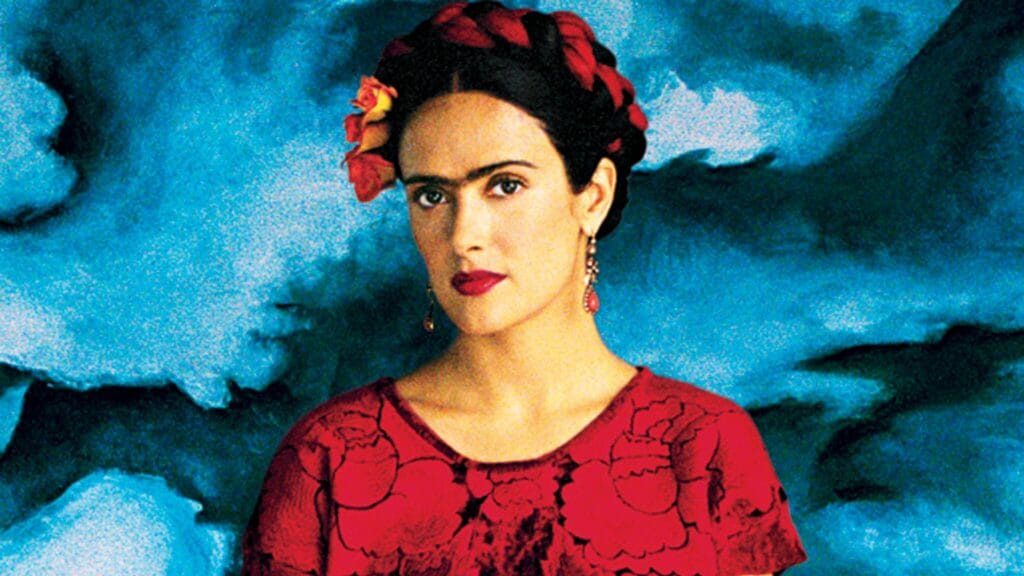
English/2h20m/2002
Synopsis: Frida Kahlo, a young student in Mexico, suffers a major blow which almost makes her immobile. Amidst the chaos, she rediscovers her purpose through painting and later rises to become one of the great artists the world has ever known.
Review:
Sometimes, being an audience is a bane because we have to tolerate watching biopics — most of the time they are cliched and lack any evolutionary essence. Like, who wants to see the same old boring success stories? As an audience, aren’t we obliged to watch entertaining content that breaks free from ice-age narratives?
‘Frida’, directed by Julie Taymor, delves into the life of one of the greatest Mexican artists Frida Kahlo. What separates this ‘biopic’ from its peers is that it does not put the protagonist on a high pedestal; instead, it explores their weaknesses and imperfections, making them more human and relatable.
After all, that is what Frida’s works are made of — imperfect, disordered elements, yet powerful ones. As the film progresses, we see not just her striking work but also what was on her mind as she picked up the painting brush. One of the conversations between Frida and her husband, Diego Rivera, says it all — like, Deigo says that Frida’s works reflect her inner agony, something which most artists wouldn’t prefer to do.
Right from the beginning, we’ll learn that Frida is someone who is a free spirited soul. Be it in her family photo (where she ditches the Mexican outfit and appears in a sharp suit like James Bond) or in the conversation with one of her boyfriends (where she asserts that reading doesn’t have to follow a specific sequence), it’s her misaligned thinking that makes such scenes stand out. Also, the unpredictability in her relationships makes the film extra spicy.
Especially her relationship with Diego Rivera is full of turbulence. Diego is a well-established Mexican muralist and a person who has been heavily influenced by communism. His trip to New York displays his love for the revolutionary idea. Oh boy! His portrayal of Lenin in the murals would’ve triggered Americans. So it’s no surprise Frida was influenced by Marxism and his work in her early years. But soon, we’ll realize that their relationship never really blossomed, as we learn about Diego.
Frida, who never really cared about his maniac nature, loses it when she learns about his affair with her very own sister. It is right after this event Frida makes a self-portrait with short hair, dressed up like Diego. Perhaps, it shows her frustration. While this part turns out to be the reason for their separation, we also learn that there’s more to it.
Diego, who opposed Stalin’s regime in Russia, offered a helping hand to his comrade Trotsky (he was exiled from Russia at that time) by accommodating him in Mexico. During this time, Frida and Trotsky had a romantic interest (a popular belief), which further complicated Frida and Diego’s relationship. We could say that the film has handled such matters carefully. Also, several scenes don’t shy away from criticizing the so-called revolutionary Stalin — something his supporters would never entertain.
(Inside her popular works)
At some point, we would understand that Frida’s imperfection is what completes her as a person and an artist. The fact that Frida uses an art form to express her emotions turns out to be a bold move. Ever since she met with an accident, she has gone through enormous physical ailments, which even changed her walking style. The spinal cord damage makes her immobile during her final years. Yet, she cleverly transforms her pain into a masterpiece, making viewers feel her emotions — her paintings ‘The Broken Column’ and ‘Without Hope’ speak volumes. She also doesn’t shy away from revealing her trauma in Henry Ford Hospital. Another radical work of hers is the depiction of an arrogant man killing his wife with needles in ‘A Few Small Nips’.
The final verdict?
This film about Frida displays her work just like a museum — at times, it even feels like a painting. We can’t help but admire the performances, even mistaking Salma Hayek for Frida. Yet, the film terribly fails in two things. Despite being set in Mexico, the characters speak English instead of Spanish — perhaps it is to reach a wider audience, but it ends up distancing us from the story. Also, at times it focuses more on Diego Rivera and not on Frida. Still, Julie Taymor somehow manages to answer the critical question: who is Frida Kahlo?